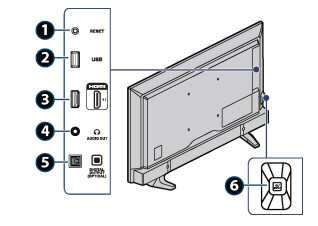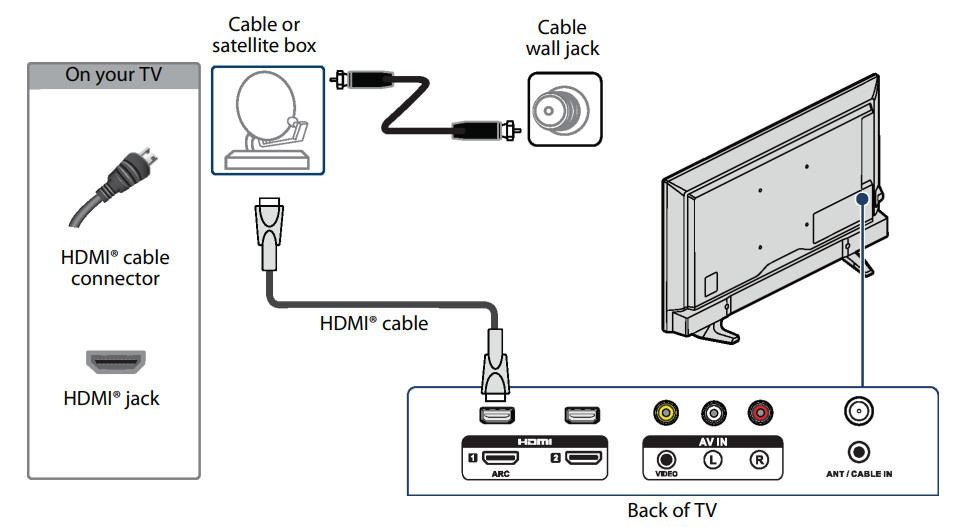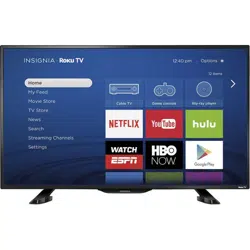Documents: Go to download!
- Owner's manual - (English)
- TV components
- What connection should I use?
- Connecting a cable or satellite box
- Connecting an antenna or cable TV (no box)
- Connecting a DVD or Blu-ray player
- Connecting a game console
- Connecting a computer
- Connecting a USB flash drive
- Connecting headphones
- Connecting external speakers or a soundbar
- Connecting a home theater system with multiple devices
- Connecting power
- Installing remote control batteries
- Maintaining
- Troubleshooting
- Specifications
Table of contents
User Manual Smart TV
TV components
Your TV has built-in controls for adjusting basic settings and several sets of jacks for connecting devices to your TV. This section contains information about:
- Package contents
- Front features
- Side jacks
- Back jacks
- Remote control
Package contents
-
39" LED TV
- Remote control and batteries (2 AAA)
- TV stands (2)
- Screws (4)
- Power cord
- Quick Setup Guide
- Important Information
Front features
Besides the viewing screen, the front has a remote control sensor, to receive the signals from the remote control (do not block), and a status indicator (see Status light on page 50.)
Side jacks
Item & Description
- RESET
- Press and hold reset for 15 seconds for a factory reset. See What if I can’t access the Factory Reset option? on page 77.
- USB
- Connect a USB flash drive to this jack to view compatible photos and videos and listen to music files. For more information, see Connecting a USB flash drive on page 29 and Playing content from USB storage devices on page 54.
- HDMI 3
- Connect an HDMI® device to this jack. For more information, see HDMI® (best) on pages 20, 24, or 26 or Connecting a computer on page 28.
-
 /AUDIO OUT
/AUDIO OUT
- Connect headphones to this jack. See Connecting headphones on page 30
- DIGITAL OUTPUT (OPTICAL)
- Connect a digital soundbar, speaker system, or home theater system to this jack to listen to TV audio through external speakers. For more information, see Digital audio using the DIGITAL OUTPUT (OPTICAL) jack on page 31.
-
 /INPUT
/INPUT
 —Press to turn on your TV when your TV is off (in standby mode). Press and hold to turn off your TV when TV is on. Warning: When your TV is off, power still flows through it. To completely disconnect power, unplug the power cord. INPUT—Quickly press and release to open the INPUT SOURCE list, press one or more times to select a video input source, then wait a few seconds. Your TV switches to the source you selected. For more information, see Switching TV inputs on page 53.
—Press to turn on your TV when your TV is off (in standby mode). Press and hold to turn off your TV when TV is on. Warning: When your TV is off, power still flows through it. To completely disconnect power, unplug the power cord. INPUT—Quickly press and release to open the INPUT SOURCE list, press one or more times to select a video input source, then wait a few seconds. Your TV switches to the source you selected. For more information, see Switching TV inputs on page 53.
Back jacks

Item & Description
- HDMI 1/ARC
- Connect an HDMI® device to this jack. For more information, see HDMI® (best) on pages 20, 24, or 26 or Connecting a computer on page 28. OR
- Connect an ARC-enabled home theater receiver to this jack. For more information, see Digital audio using the ARC jack on page 32.
- HDMI 2
- Connect an HDMI® device to this jack. For more information, see HDMI® (best) on pages 20, 24, or 26 or Connecting a computer on page 28.
- VIDEO and L and R (audio)
- Connect the video and audio for an AV device to these jacks. For more information, see AV (composite video) (good) on page 21, 25, or 27.
- ANT / CABLE IN
- Connect an antenna or cable TV to this jack. For more information, see Coaxial (good) on page 22 or Connecting an antenna or cable TV (no box) on page 23.
Remote control
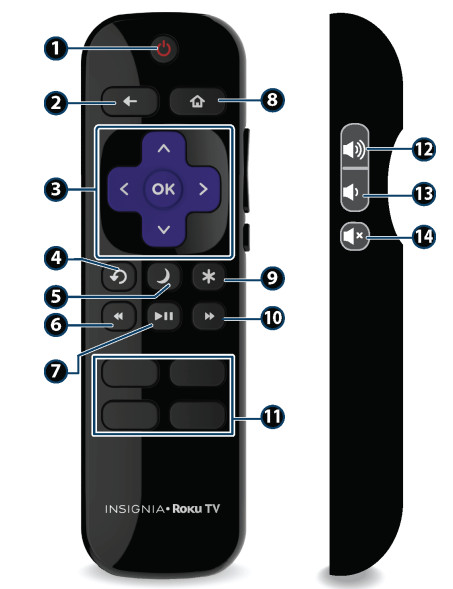
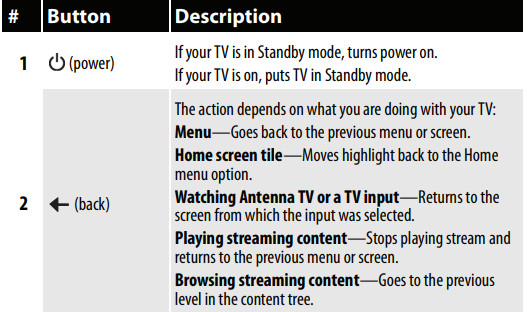
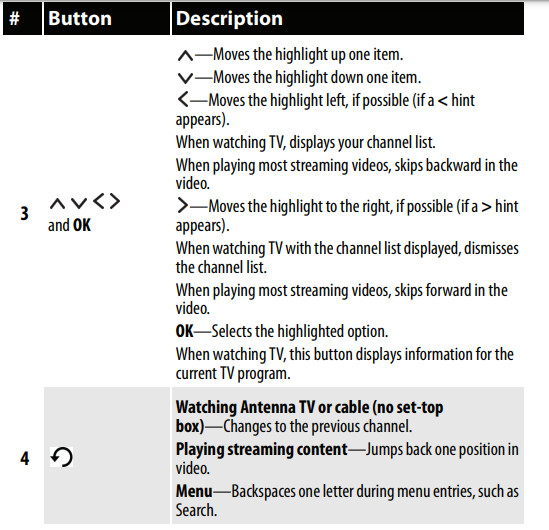
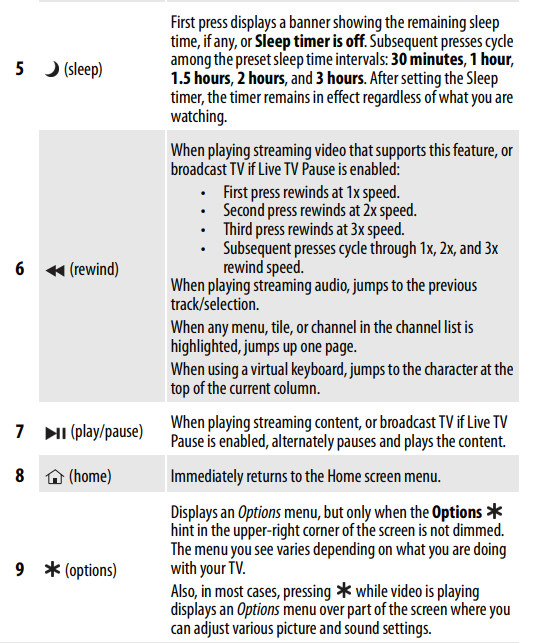
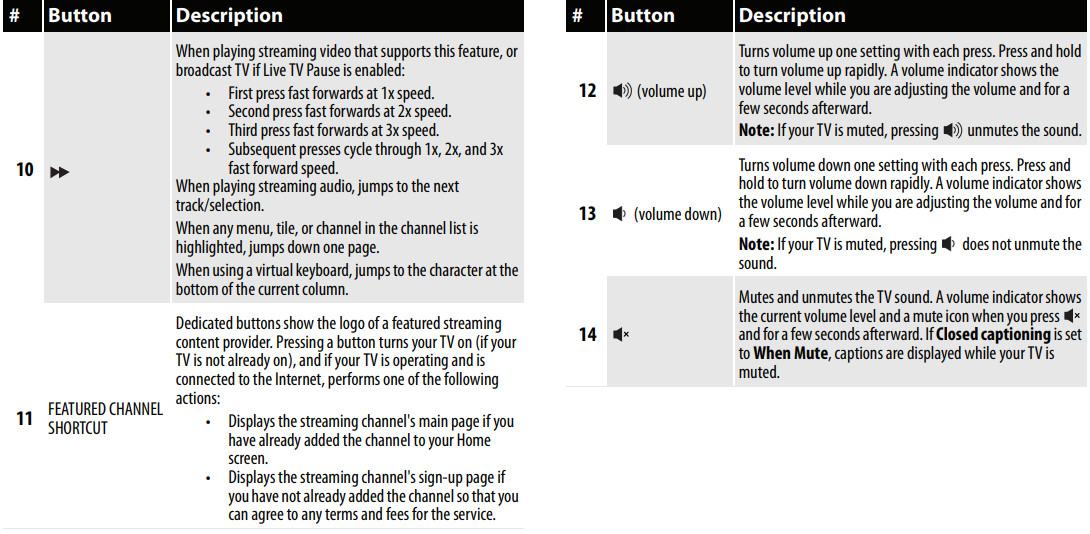
What connection should I use?
Your TV has several connection types for connecting devices to your TV. For the best video quality, you should connect a device to the best available connection. Use the following tables to identify cables:
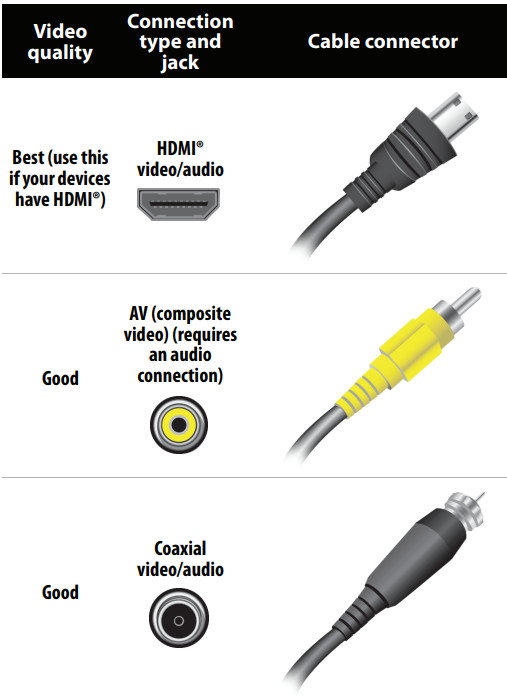
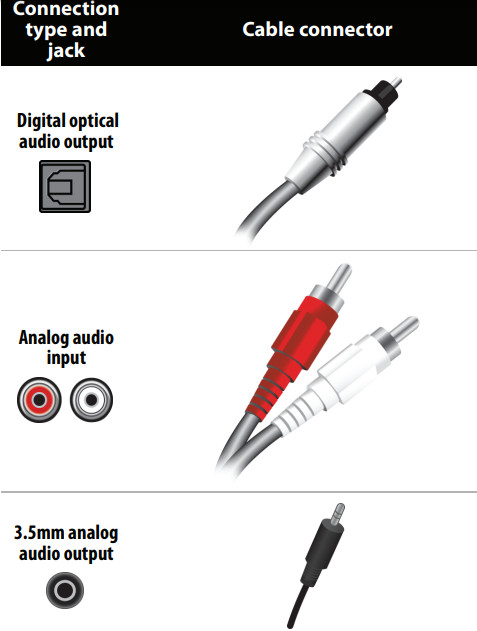
Cautions
- Check the jacks for position and type before making any connections.
- Loose connections can cause poor audio or video quality. Make sure that all connections are tight and secure.
- The external audio/video devices shown may be different from your devices. If you have questions, refer to the documentation that came with your devices.
- Always turn off your TV when connecting external devices.
Connecting a cable or satellite box
HDMI® (best)
- Make sure that your TV’s power cord is unplugged and all connected devices are turned off.
- Connect the incoming cable from the cable wall jack to the cable-in jack on the cable or satellite box.
- Connect an HDMI® cable (not provided) to an HDMI jack on the back or side of your TV and to the HDMI OUT jack on the cable or satellite box.
- Plug your TV’s power cord into a power outlet, turn on your TV, then turn on the cable or satellite box.
-

AV (composite video) (good)
Notes Cables are often color-coded to match color-coded jacks.
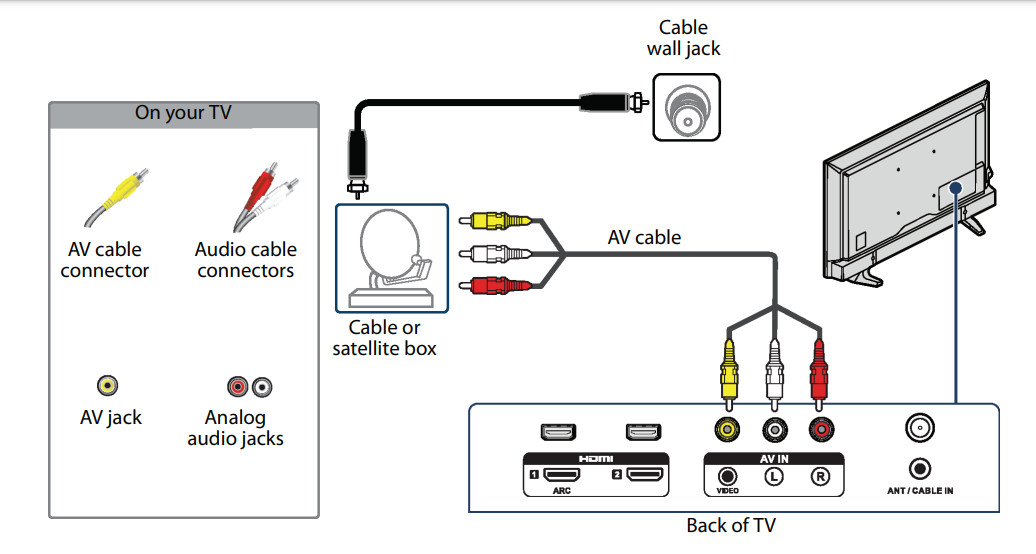
- Make sure that your TV’s power cord is unplugged and all connected devices are turned off.
- Connect the incoming cable from the cable wall jack to the cable-in jack on the cable or satellite box.
- Connect an AV cable (not provided) to the VIDEO jack and L and R audio jacks on the back of your TV and to the AV and audio out jacks on the cable or satellite box.
- Note When you connect the audio using the L and R audio jacks, the audio output is analog.
- Plug your TV’s power cord into a power outlet, turn on your TV, then turn on the cable or satellite box.
-

Coaxial (good)

- Make sure that your TV’s power cord is unplugged and all connected devices are turned off.
- Connect the incoming cable from the cable wall jack to the cable-in jack on the cable or satellite box.
- Connect a coaxial cable (not provided) to the ANT / CABLE IN jack on the back of your TV and to the coaxial out jack on the cable or satellite box.
- Plug your TV’s power cord into a power outlet, turn on your TV, then turn on the cable or satellite box.
- Set up the TV tuner to watch broadcast TV. See Setting up Antenna TV on page 46.
- On the Home screen, press
 to highlight the Antenna TV tile, then press OK.
to highlight the Antenna TV tile, then press OK.
Notes
- Use a coaxial cable to eliminate interference and noise from radio waves.
- Do not bundle the coaxial cable with the power cord or other cables.
Connecting an antenna or cable TV (no box)
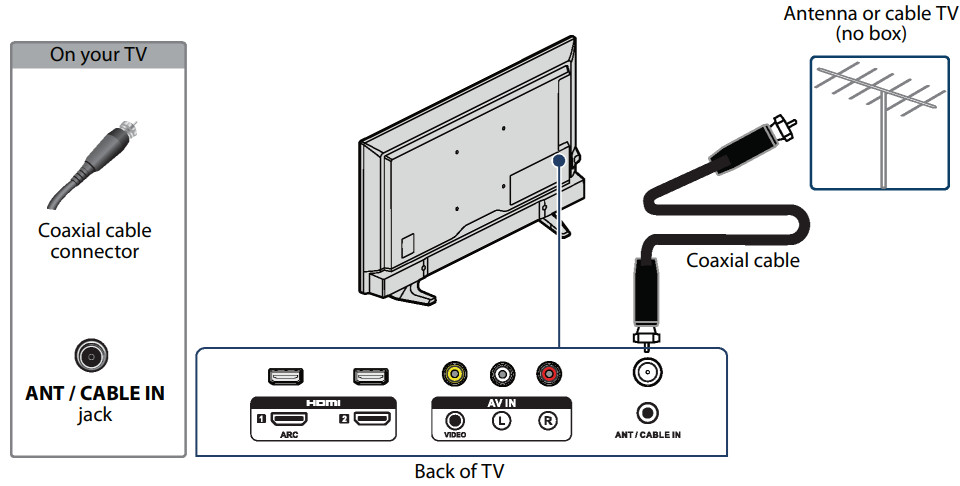
- Make sure that your TV’s power cord is unplugged and all connected devices are turned off.
- Connect a coaxial cable (not provided) to the ANT / CABLE IN jack on the back of your TV and to the antenna or cable TV wall jack.
- Plug your TV’s power cord into a power outlet, then turn on your TV.
- On the Home menu, press
 the highlight the tile for Antenna TV, then press OK.
the highlight the tile for Antenna TV, then press OK. - Set up the TV tuner to watch broadcast TV. See Setting up Antenna TV on page 46.
- On the Home screen, press
 to highlight the Antenna TV tile, then press OK.
to highlight the Antenna TV tile, then press OK.
Notes
- Use a coaxial cable to eliminate interference and noise from radio waves.
- Do not bundle the coaxial cable with the power cord or other cables.
- If the antenna is not installed correctly, contact qualified service personnel to correct the problem.
- If the signal level for a channel is weak, the picture may be distorted. Adjust the antenna or use a highly directional outdoor or set-top antenna with a built-in amplifier.
- If the picture quality is good on some channels and poor on others, the problem may be caused by a poor or weak signal from the broadcaster or cable TV provider.
- If you connect to cable TV without a set-top box and experience poor picture quality, you may need to install a set-top box to improve signal reception and picture quality. Contact your cable TV provider about upgrading to a set-top box.
- Many high-definition (HD) channels upscale standard-definition (SD) content. The picture displayed on your TV is still displayed as SD, thus the picture quality will not be as clear or crisp as it would be if the content was originally recorded in HD.
Connecting a DVD or Blu-ray player
HDMI® (best)

- Make sure that your TV’s power cord is unplugged and the DVD or Blu-ray player is turned off.
- Connect an HDMI® cable (not provided) to an HDMI jack on the back or side of your TV and to the HDMI OUT jack on the DVD or Blu-ray player.
- Plug your TV’s power cord into a power outlet, then turn on your TV and DVD or Blu-ray player.
- On the Home screen, press
 to highlight the HDMI 1, HDMI 2, or HDMI 3 tile, then press OK.
to highlight the HDMI 1, HDMI 2, or HDMI 3 tile, then press OK.
Note An HDMI® cable carries both audio and video. You do not need to use any audio cables.
AV (composite video) (good)
Note Cables are often color-coded to match color-coded jacks.
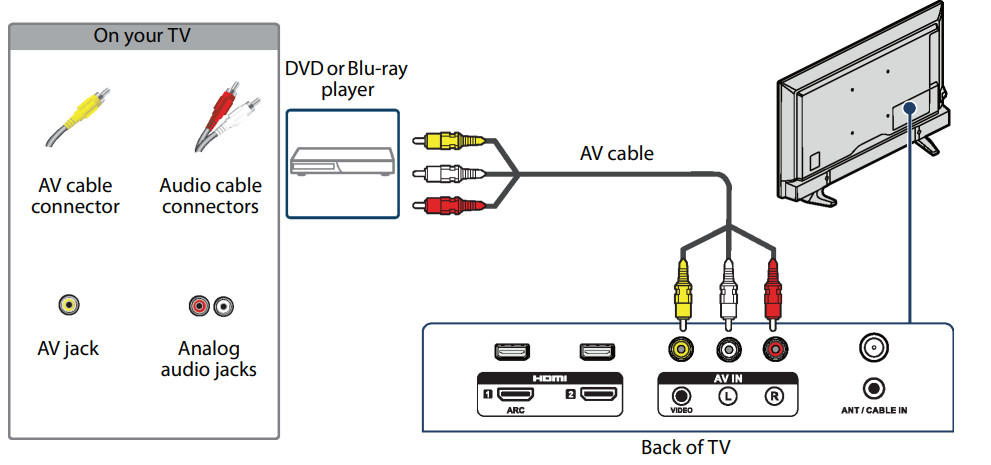
- Make sure that your TV’s power cord is unplugged and the DVD or Blu-ray player is turned off.
- Connect an AV cable (not provided) to the VIDEO jack and L and R audio jacks on the back of your TV and to the AV OUT jacks on the DVD or Blu-ray player.
- Note When you connect the audio using the L and R audio jacks, the audio output is analog.
- Plug your TV’s power cord into a power outlet, then turn on your TV and DVD or Blu-ray player.
- On the Home screen, press
 to highlight the AV tile, then press OK
to highlight the AV tile, then press OK
Connecting a game console
HDMI® (best)
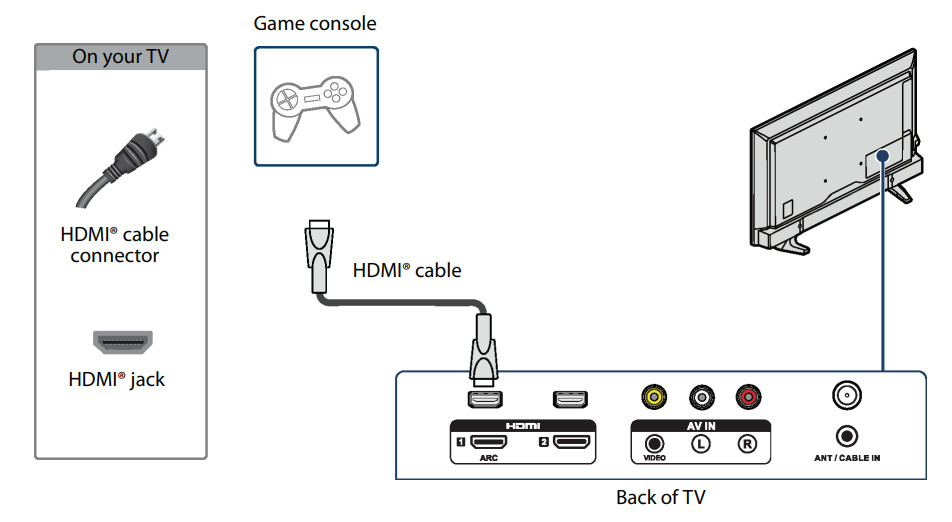
- Make sure that your TV’s power cord is unplugged and the game console is turned off.
- Connect an HDMI® cable (not provided) to an HDMI jack on the back or side of your TV and to the HDMI OUT jack on the game console.
- Plug your TV’s power cord into a power outlet, then turn on your TV and the game console.
- On the Home screen, press
 to highlight the HDMI 1, HDMI 2, or HDMI 3 tile, then press OK.
to highlight the HDMI 1, HDMI 2, or HDMI 3 tile, then press OK.
- Note An HDMI® cable carries both audio and video. You do not need to use any audio cables.
AV (composite video) (good)
Note Cables are often color-coded to match color-coded jacks
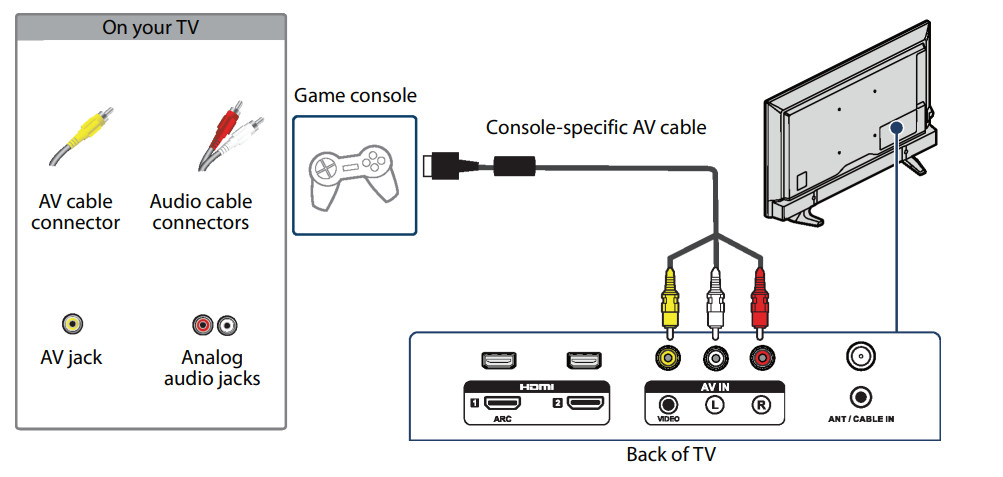
- Make sure that your TV’s power cord is unplugged and the game console is turned off.
- Connect the game console’s AV cable (not provided) to the VIDEO jack and L and R audio jacks on the back of your TV and to the composite jack(s) on the game console.
- Note
- Some older game consoles come with a special AV cable. See the documentation that came with your game console or check the manufacturer’s website.
- When you connect the audio using the L and R audio jacks, the audio output is analog.
- Note
- Plug your TV’s power cord into a power outlet, then turn on your TV and the game console.
- On the Home screen, press
 to highlight the AV tile, then press OK.
to highlight the AV tile, then press OK.
Connecting a computer
You can use an HDMI® jack on your TV to connect to a computer.
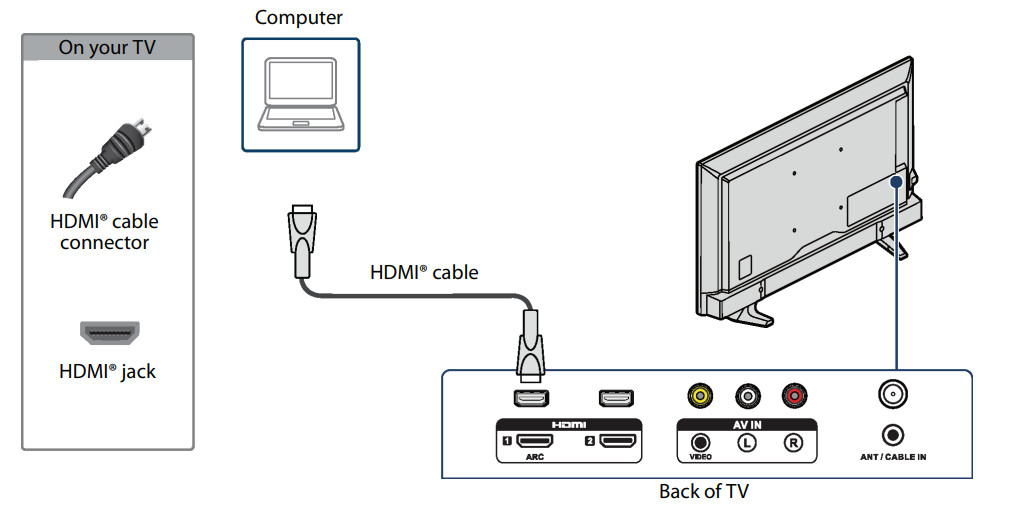
- Make sure that your TV’s power cord is unplugged and the computer is turned off.
- Connect an HDMI® cable (not provided) to an HDMI jack on the back or side of your TV and to the HDMI OUT jack on the computer.
- Plug your TV’s power cord into a power outlet, then turn on your TV and the computer.
- On the Home screen, press
 to highlight the HDMI 1, HDMI 2, or HDMI 3 tile, then press OK.
to highlight the HDMI 1, HDMI 2, or HDMI 3 tile, then press OK. - Adjust the display properties on the computer, if necessary
Connecting a USB flash drive
You can use the USB jack on your TV to view photos and videos and listen to music stored on a USB flash drive.
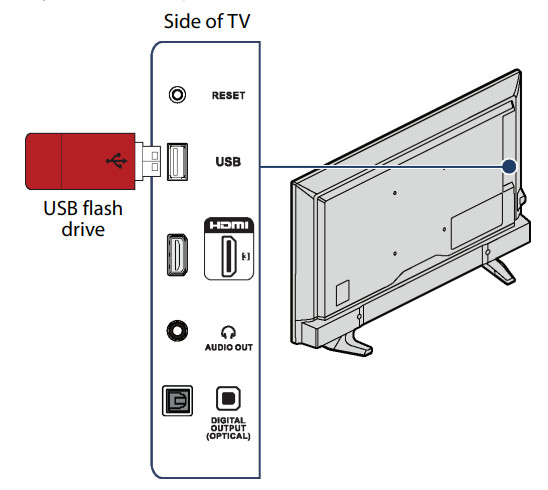
- Plug a USB flash drive into the USB port on the side of your TV.
- Caution Do not remove the USB flash drive or turn off your TV while using the USB flash drive. You may lose data or damage the USB flash drive.
-

Connecting headphones
When you connect headphones, your TV speakers are muted and sound only plays through the headphones.
Warning Loud noise can damage your hearing. When using headphones, use the lowest volume setting on your headphones that still lets you hear the sound.
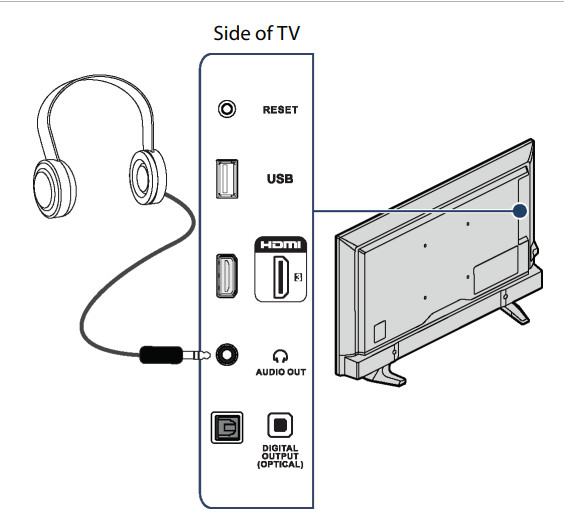
- Connect the headphones to the
 /AUDIO OUT jack on the side of your TV.
/AUDIO OUT jack on the side of your TV.
Connecting external speakers or a soundbar
Digital audio using the DIGITAL OUTPUT (OPTICAL) jack
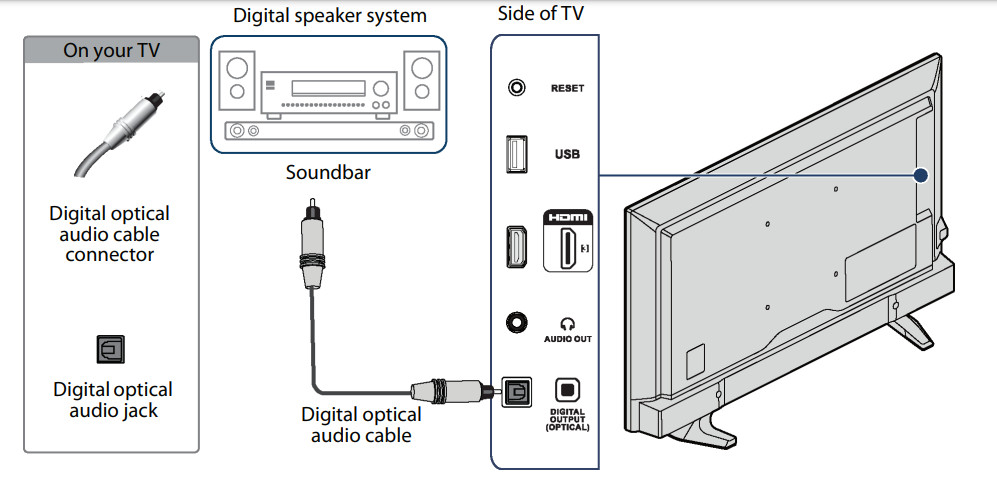
- Make sure that your TV’s power cord is unplugged and the digital speaker system or soundbar is turned off.
- Connect a digital optical audio cable (not provided) to the DIGITAL OUTPUT (OPTICAL) jack on the side of your TV and to the digital optical AUDIO IN jack on the digital speaker system or soundbar.
- Plug your TV’s power cord into a power outlet, then turn on your TV.
- Turn on the digital speaker system or soundbar, then set it to the correct source. For more information, see the documentation that came with the digital speaker system or soundbar.
- To turn off your TV speakers, on the Home menu, press
 to highlight Settings, then press OK. Highlight Audio, then press OK. Highlight TV speakers, then press OK. Press OK to remove the check from the TV speakers enabled check box.
to highlight Settings, then press OK. Highlight Audio, then press OK. Highlight TV speakers, then press OK. Press OK to remove the check from the TV speakers enabled check box.
Digital audio using the ARC jack
Your TV can send sound to an ARC device, like an AV receiver, to create a home theater that uses two or more speakers. When you connect external speakers or a soundbar, sound plays through your TV speakers and the external speakers or soundbar.

- Make sure that your TV’s power cord is unplugged and the digital speaker system or soundbar is turned off.
- Connect an HDMI® cable (not provided) to the HDMI 1/ARC jack on the back of your TV and to the HDMI IN jack on the digital speaker system or soundbar.
- Plug your TV’s power cord into a power outlet, then turn on your TV.
- Turn on the digital speaker system or soundbar, then set it to the correct source. For more information, see the documentation that came with the digital speaker system or soundbar.
- To turn off your TV speakers, on the Home menu, press
 to highlight Settings, then press OK. Highlight Audio, then press OK. Highlight TV speakers, then press OK. Press OK to remove the check from the TV speakers enabled check box.
to highlight Settings, then press OK. Highlight Audio, then press OK. Highlight TV speakers, then press OK. Press OK to remove the check from the TV speakers enabled check box. - To configure the HDMI 1/ARC jack to output sound to an ARC device, on the Home menu, press or to highlight Settings, then press OK. Highlight System, then press OK. Highlight Control other devices (CEC), then press OK. Highlight HDMI ARC, then press OK to check the box.
Analog audio
When you connect an analog system or soundbar to the  /AUDIO OUT jack, your TV speakers are muted.
/AUDIO OUT jack, your TV speakers are muted.
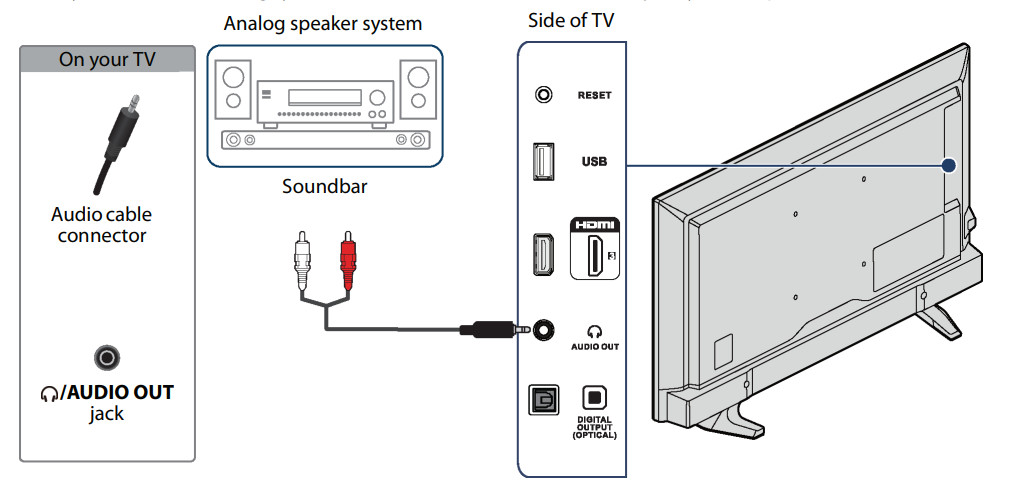
- Make sure that your TV’s power cord is unplugged and the analog speaker system or soundbar is turned off.
- Connect an audio cable (not provided) to the
 /AUDIO OUT jack on the side of your TV and to the AUDIO IN jacks on the analog speaker system or soundbar.
/AUDIO OUT jack on the side of your TV and to the AUDIO IN jacks on the analog speaker system or soundbar. - Plug your TV’s power cord into a power outlet, then turn on your TV.
- Turn on the analog speaker system or soundbar, then set it to the correct source. For more information, see the documentation that came with the analog speaker system or soundbar.
Note Use the volume controls on the analog speaker system or soundbar to control the volume.
Connecting a home theater system with multiple devices
You can connect an AV receiver and your devices to create a home theater.
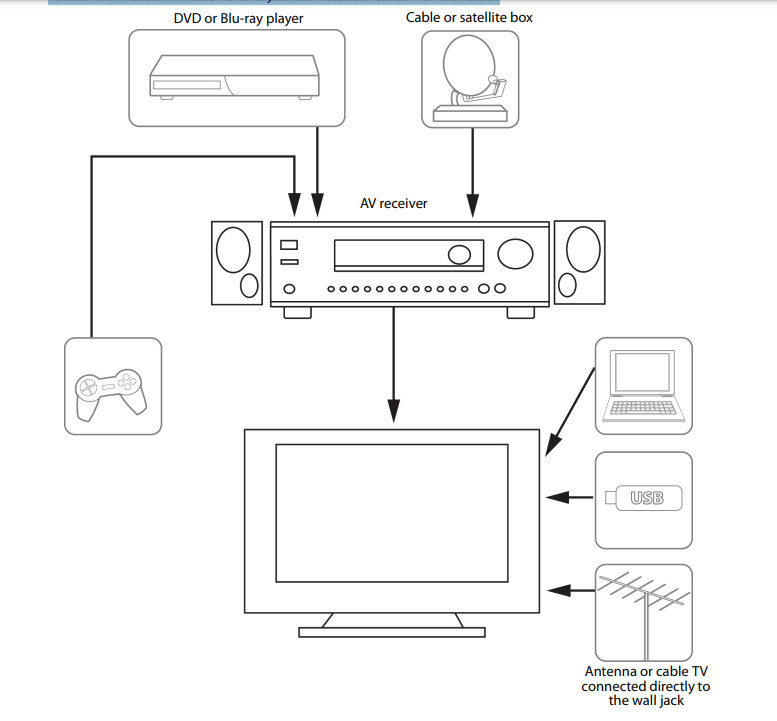
The connections you make depend on the video and audio jacks available on your devices. Refer to the documentation that came with your devices for connection information. Just remember to use the best connection types available for the best picture and sound. For information about connection types, see What connection should I use? on page 19. For information about TV settings for home theaters, see Using your TV in a home theater on page 74.
Connecting power
You should connect devices before you connect the power cord. When you are adding devices, make sure that the power cable is unplugged from the power outlet.

- Connect the AC power cord to the power connector on the back of your TV.
- Connect the other end of the cord to a power outlet.
Caution
- Your TV should only be operated from the power source indicated on the label.
- Always unplug the power cord from the power outlet when you will not be using your TV for an extended period of time.
Installing remote control batteries
Open the back of your TV remote control and insert two AAA batteries, observing the proper orientation. Reattach the back cover.
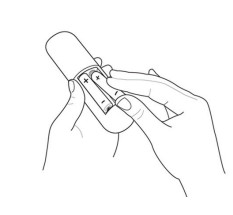
Remote control on page 17 explains how to use the remote control in each of your TV’s operating modes.
Cautions
- Batteries should not be exposed to excessive heat, such as sunshine, heat registers, or fire.
- Battery chemicals can cause a rash. If the batteries leak, clean the battery compartment with a cloth. If chemicals touch your skin, wash immediately.
- Make sure that batteries are disposed of correctly. Do not burn or incinerate.
Notes
- Do not mix batteries of different types.
- Do not mix old and new batteries.
- Remove batteries when the charge is depleted.
- If the remote control is not going to be used for an extended period of time, remove the batteries.
Aiming the remote control
- Point the remote control towards the remote sensor on the front of your TV.
Maintaining
- Do not use your TV in areas that are too hot or too cold, because the cabinet may warp or the screen may malfunction. Your TV works best in temperatures that are comfortable to you.
- Storage temperatures are 5° to 113°F (-15° to 45°C).
- Working temperatures are 41° to 95°F (5° to 35°C).
- Do not place your TV in direct sunlight or near a heat source.
Cleaning your TV cabinet
Clean the cabinet with a soft, lint-free cloth. If the cabinet is especially dirty, moisten a soft, lint-free cloth in a weak detergent solution, squeeze the excess moisture from the cloth, then wipe the cabinet with the cloth. Use a clean cloth to dry the cabinet.
Cleaning your TV screen
Clean the screen with a soft, lint-free cloth.
Troubleshooting
Warning Do not try to repair your TV yourself. Contact authorized service personnel
Note If the problem is not solved by using these troubleshooting instructions, turn off your TV, then turn it on again.
Note If you have any other questions about how to use your TV that are not covered in this User Guide, go to http://support.roku.com and select your TV brand and model.
Video and audio
- Picture does not fill the screen or there are black bars around the picture
- The picture size may need to be adjusted
- Adjust the picture size (aspect ratio). See the Picture Size option in Options menu settings on page 56.
- The picture size may need to be adjusted
- I don’t see a picture when I select an input
- TV is not on
- Make sure that your TV is plugged into a working power outlet, and that your TV is turned on. (Your TV has a light on the front that indicates if your TV is turned off. See Status light on page 50.)
- Cables are not connected correctly
- Make sure that the video cables are connected correctly and securely to your TV.
- Make sure that the antenna or cable TV is connected correctly and securely. See Connecting a cable or satellite box on page 20 or Connecting an antenna or cable TV (no box) on page 23.
- Picture settings may be incorrect
- Adjust the contrast and brightness. See the TV brightness option in Settings menu on page 55 or Options menu on page 55.
- Adjust the TV picture. See Advanced picture settings on page 57
- Incorrect input may be selected
- Make sure that the correct input is selected for the device you want to view. See Switching TV inputs on page 53.
- Input source not detected
- Make sure that the device connected to the input is turned on.
- Make sure that the cord to and from the device is connected firmly and correctly to the device and your TV.
- TV input may be bad
- Connect a different device to the same input and check to see if it works correctly
- TV is not on
- TV channel does not appear
- Broadcast TV may be experiencing problems or may not be set up
- Try another channel. The station may be experiencing problems.
- Make sure that the incoming signal is compatible.
- If you are trying to watch broadcast TV, make sure that Antenna TV is set up. See Setting up Antenna TV on page 46.
- Broadcast TV may be experiencing problems or may not be set up
- Dark, poor, or no picture (screen is lit), but sound is good
- Broadcast TV may be experiencing problems or may not be set up
- Try another channel. The station may be experiencing problems.
- If you are using an antenna and the signal strength is low, adjust the antenna or use a highly directional outdoor antenna or set-top antenna with a built-in amplifier.
- Cables may not be connected correctly
- Make sure that the antenna or cable TV is connected correctly and securely. See Connecting a cable or satellite box on page 20 or Connecting an antenna or cable TV (no box) on page 23.
- Make sure that the video cables are connected correctly and securely to your TV.
- The video cable(s) you are using may be bad. Try a new set.
- Picture settings may be incorrect
- Adjust the brightness. See the TV brightness option in Settings menu on page 55 or Options menu on page 55.
- Change to a different picture mode. See the Picture mode option in Options menu settings on page 56 or Advanced Picture Settings menu options on page 57.
- Broadcast TV may be experiencing problems or may not be set up
- No color, dark picture, or color is not correct
- Picture settings may be incorrect
- Adjust the contrast, color, and brightness settings. See the TV brightness option in Settings menu on page 55 or Options menu on page 55.
- Broadcast TV may be experiencing problems
- Try another channel. The station may be experiencing problems.
- If you are using an antenna and the signal strength is low, adjust the antenna or use a highly directional outdoor antenna or set-top antenna with a built-in amplifier
- Cables are not be connected correctly
- Make sure that the antenna or cable TV is connected correctly and securely. See Connecting a cable or satellite box on page 20 or Connecting an antenna or cable TV (no box) on page 23.
- Make sure that the video cables are connected correctly and securely to your TV.
- The video cable(s) you are using may be bad. Try a new set
- Picture settings may be incorrect
- Only snow (noise) appears on the screen
- Broadcast TV may be experiencing problems or may not be set up
- Try another channel. The station may be experiencing problems.
- If you are trying to watch broadcast TV, make sure that Antenna TV is set up. See Setting up Antenna TV on page 46.
- If you are using an antenna and the signal strength is low, adjust the antenna or use a highly directional outdoor antenna or set-top antenna with a built-in amplifier.
- Cables may not be connected correctly
- Make sure that the antenna or cable TV is connected correctly and securely. See Connecting a cable or satellite box on page 20 or Connecting an antenna or cable TV (no box) on page 23.
- Broadcast TV may be experiencing problems or may not be set up
- Picture quality is good on some channels and poor on others. Sound is good
- Broadcast signal may be weak
- If you connect to cable without a set-top box and experience poor picture quality, you may need to install a set-top box to improve signal reception and picture quality. Contact your cable TV provider about upgrading to a set-top box.
- Broadcast signal may be weak
- Dotted lines or stripes appear on the screen
- Cables may not be connected correctly
- Make sure that the antenna or cable TV is connected correctly and securely. See Connecting a cable or satellite box on page 20 or Connecting an antenna or cable TV (no box) on page 23.
- Make sure that the video cables are connected correctly and securely to your TV.
- The video cable(s) you are using may be bad. Try a new set.
- Broadcast signal may be weak
- If you are using an antenna and the signal strength is low, adjust the antenna or use a highly directional outdoor antenna or set-top antenna with a built-in amplifier.
- Other devices (for example, a surround sound receiver, external speakers, fans, or hair dryers) may be interfering with your TV. Try turning off one device at a time to determine which device is causing interference. After you have determined which device is causing interference, move it further from your TV to eliminate the interference.
- Cables may not be connected correctly
- Double images
- Broadcast signal may be weak
- If you are using an antenna and the signal strength is low, adjust the antenna or use a highly directional outdoor antenna or set-top antenna with a built-in amplifier.
- If you are using an antenna and the signal strength is low, switch to a cable or satellite box.
- Broadcast signal may be weak
- The picture has a few bright or dark spots
- This is normal in LED TVs
- A few bright or dark spots on a TV screen is normal. It does not affect the operation of your TV.
- This is normal in LED TVs
- Good picture, but no sound
- Volume is down or muted
- Increase the volume.
- Make sure that the sound is not muted.
- Headphones may be connected
- Make sure that you do not have headphones connected. When headphones are connected, no sound comes from your TV speakers.
- TV speakers may be turned off
- If you want sound to play through your TV speakers, make sure that your TV speakers are turned on. See Turning off the speakers on page 74.
- You may need to change the audio mode
- Change to a different audio mode. See Changing the audio mode on page 74.
- Home theater system, soundbar, or external speaker system may not be turned on or may not be set up correctly
- If you are using a home theater system, soundbar, or external speaker system, make sure that it is turned on and is not muted and that it is set to the correct source.
- If you connected an ARC audio device to the HDMI 1/ARC jack, make sure that you have turned on the ARC feature. See the HDMI ARC option in Setting up a digital audio connection on page 75.
- If you are using a home theater system, soundbar, or external speaker system and have connected it with a digital audio cable, see Setting up a digital audio connection on page 75.
- Make sure that the audio cables are connected correctly and securely to your TV.
- Bad content, no audio
- Make sure that the selected channel or content is intended to be broadcasting with sound.
- Cables may not be connected correctly
- Make sure that the antenna or cable TV is connected correctly and securely. See Connecting a cable or satellite box on page 20 or Connecting an antenna or cable TV (no box) on page 23.
- The audio cables you are using may be bad. Try a new set.
- Poor picture
- Light in the viewing area may be interfering
- Make sure that the room is not too bright. Light reflecting off the screen can make the picture difficult to see.
- A connected camera or camcorder may be interfering
- If an S-VHS camera or a camcorder is connected while another connected device is turned on, the picture may be poor. Turn off one or more devices.
- Light in the viewing area may be interfering
- Audio noise
- Other devices may be interfering
- Other devices (for example, a surround sound receiver, external speakers, fans, or hair dryers) may be interfering with your TV. Try turning off one device at a time to determine which device is causing interference. After you have determined which device is causing interference, move it further from your TV to eliminate the interference.
- Other devices may be interfering
- After images appear
- Do not display a still image, such as a logo, game, or computer image, for an extended period of time. This can cause a permanent after-image to be burned into the screen. This type of damage is not covered by your warranty
- Volume is down or muted
Remote control
- My TV doesn’t turn on using the remote control
- No power to TV
- Make sure that the power cord is correctly connected to both the TV power connector and power outlet. See Connecting power on page 35. You should see an LED in the front of the TV panel when a button on the remote is pressed. If you see no LED activity, try another outlet or check your fuse box.
- Line-of-sight obstructed
- Make sure that no objects (or pets) are obstructing the line-of-sight from the remote control to the remote sensor on the front of your TV. See Aiming the remote control on page 36.
- Remote not responding
- Open the battery compartment and make sure that the batteries are seated in the correct positions (+ and - in the correct positions). See Installing remote control batteries on page 36.
- Make sure the batteries are fresh and working correctly. Replace the batteries, if necessary
- TV frozen
- If the front LED is not responding, or abnormally bright, disconnect the power cord from power outlet, wait a few seconds, then reconnect the power cord.
- No power to TV
- Trouble programming your existing universal remote control
- Remote control may not be programmed correctly
- See instructions in Using a universal remote on page 79. For instructions on programing a universal remote control, visit: www.roku.com/universalremote
- Refer to the User Guide that accompanied your universal remote control and contact the manufacturer if problems persist.
- Batteries may be dead
- Replace dead batteries with new batteries. Refer to the User Guide that accompanied your universal remote control.
- Remote control may not be programmed correctly
General
- No power
- Power cord may not be connected correctly
- Make sure that the power cord is correctly connected to both your TV power connector and power outlet. See Connecting power on page 35. You should see an LED in the front of your TV panel when a button on the remote is pressed. If you see no LED activity, try another outlet or check your fuse box.
- Unplug the power cord, wait 60 seconds, then plug the cord back in and turn on your TV.
- Power cord may not be connected correctly
- Other devices may be interfering
- Other devices (for example, a surround sound receiver, external speakers, fans, or hair dryers) may be interfering with your TV. Try turning off one device at a time to determine which device is causing interference. After you have determined which device is causing interference, move it further from your TV to eliminate the interference.
- My TV tuner does not pick up as many over-the-air channels as it should
- Antenna may not be placed optimally
- Adjust the antenna location and rescan. See Scanning for broadcast TV channels again on page 74. Go to Settings > TV inputs > Antenna TV > Scan again for channels.
- Reception can vary by channel depending on the broadcast power level of a given station. Contact your cable or satellite TV provider.
- Make sure that the antenna or cable/satellite TV is connected securely to your TV.
- Try replacing the cable between the antenna/cable or cable/satellite box and your TV.
- Broadcast TV may not be set up
- Make sure that Antenna TV is set up. See Setting up Antenna TV on page 46.
- Antenna may not be placed optimally
- One or more channels do not display
- Channels may be blocked or hidden
- Make sure that the channels are not blocked. See Blocking unrated programs on page 72.
- Make sure that the channels are not hidden. The channel may have been deleted from the channel list. You can add the channel back to the channel list. See Edit broadcast TV channel lineup on page 64.
- The wrong input may be selected
- Make sure that you have selected the correct input tile for the device or service you are trying to use. See Switching TV inputs on page 53.
- You may need to use the remote control that came with the cable or satellite box
- If you are using a cable or satellite box, use the remote that came with that box to change channels.
- Channels may be blocked or hidden
- I lost my parental control PIN
- Need PIN recovery
- You will need to factory reset your TV, as the PIN cannot be recovered or reset any other way. See Factory reset everything on page 76. Go to Settings>System>Factory reset.
- Need PIN recovery
- Some settings cannot be accessed
- Not all settings are available for all devices or inputs
- If the
 icon or a menu option is grayed, you cannot adjust settings for the current video input mode.
icon or a menu option is grayed, you cannot adjust settings for the current video input mode.
- If the
- Not all settings are available for all devices or inputs
- TV cabinet creaks
- This is normal
- When your TV is in use, the temperature rises naturally and may cause the cabinet to expand or contract which can cause a creaking noise. This is not a malfunction.
- This is normal
- Control buttons do not work
- TV may be frozen
- Unplug the power cord, wait a few seconds, then plug the cord back in and turn on your TV.
- TV may be frozen
- TV keeps turning off
- Sleep time may be turned on
- Make sure that the sleep timer is not turned on. See the Sleep Timer option in Options menu settings on page 56 or Changing time settings on page 74.
- Sleep time may be turned on
- Some features are not available
- The wrong TV mode may be selected
- You may have selected Set up for store use when you set up your TV. In Store use mode, some of your TV’s features are missing or limited. If you selected Set up for store use and you want to change to Set up for home use, you have to reset your TV to the factory defaults. See Factory reset everything on page 76. Go to Settings>System>Factory reset.
- The wrong TV mode may be selected
Roku
- I can’t turn my TV on with the Roku mobile app
- Your TV is “asleep”
- You will need to use the physical remote button to “wake up” or turn on your TV.
- Your TV is “asleep”
- I can’t find my TV with the Roku mobile app
- TV and mobile app not on same wireless network
- Make sure that your TV and the mobile app are on the same network.
- TV not powered or working normally
- Make sure that your TV is connected to a working power outlet and that your TV is turned on. See Connecting power on page 35.
- TV and mobile app not on same wireless network
Network
- I cannot connect to the Internet
- Network connection may not be set up
- If you did not connect to the Internet when you first set up your TV, see But what if I didn’t connect my TV? on page 46.
- Network name or password may have changed
- If your network name or password had changed, you need to update your network connection. See Changing network settings on page 73.
- Network connection may not be set up
- Streaming keeps pausing to load more data
- Wireless LAN not optimized
- Rotate wireless router slightly
- Elevate the router
- Turn off other wireless connections
- Use 5.0Ghz, if possible. Roku TVs supports dual band.
- Insufficient broadband speed
- Turn off other wireless connections that may also be using bandwidth.
- Wireless LAN not optimized
CEC-compatible devices
- My TV is not displaying the video from the connected CEC device
- Cables may not be connected correctly
- Make sure that the HDMI® cable is connected securely to your TV and the device.
- Make sure that the device is connected to your TV with an HDMI® cable.
- Picture settings may be incorrect
- Try adjusting your TV picture. See Advanced picture settings on page 57.
- The selected input may be incorrect
- Make sure that the correct input tile is selected. See Switching TV inputs on page 53
- Connected device may not be a CEC device
- Make sure that the device is a CEC device. See the documentation that came with the device for more information.
- CEC control may not be set up correctly
- Make sure that your TV has searched for CEC devices. See Discovering connected CEC devices on page 75.
- Cables may not be connected correctly
- My TV is not playing the audio from the connected CEC device
- Cables may not be connected correctly
- Make sure that the HDMI® cable is connected securely to your TV and the device.
- Volume may be too low or muted
- Make sure that the volume on your TV and the device is turned up and not muted.
- TV speakers may be turned off
- If you want sound to play through your TV speakers, make sure that your TV speakers are turned on. See Turning off the speakers on page 74.
- Connected device may not be a CEC device
- Make sure that the device is a CEC device. See the documentation that came with the device.
- CEC control may not be set up correctly
- Make sure that your TV has searched for CEC devices. See Discovering connected CEC devices on page 75.
- Connected audio device may not be set up correctly
- If you are using a home theater system, soundbar, or external speaker system, make sure that it is set to the correct source.
- If you are using a home theater system, soundbar, or external speaker system and have connected it with a digital audio cable, make sure that you have set up digital audio. See Setting up a digital audio connection on page 75.
- If you connected an ARC audio device to the HDMI 1/ARC jack, make sure that you have turned on the ARC feature. See Enabling HDMI ARC on page 75
- Cables may not be connected correctly
- My TV’s remote control does not control the device
- Connected device may not be turned on
- Make sure that the device is turned on.
- Line-of-sight obstructed
- Make sure that no objects (or pets) are obstructing the line-of-sight from the remote control to the remote sensor on the front of your TV and the device. See Aiming the remote control on page 36.
- Connected device may not support some or all CEC features
- Depending on the device, all the buttons may not work.
- The device may not support this feature. See the documentation that came with the device for more information.
- CEC control may not be set up correctly
- Make sure that your TV has searched for CEC devices. See Discovering connected CEC devices on page 75.
- If you are trying to control the volume on an HDMI® CEC audio receiver using your TV remote control, make sure that your TV speakers are turned on. See Turning off the speakers on page 74.
- If you are trying to control the volume on an HDMI® CEC audio receiver using your TV remote control, make sure that the system audio control is turned on. See Enabling system audio control on page 76.
- Connected device may not be turned on
- The device does not show up in the CEC device list
- Connected device may not be a CEC device
- Make sure that the device is a CEC device. See the documentation that came with the device.
- Cables may not be connected correctly
- Make sure that the HDMI® cable is connected securely to your TV and the device.
- Make sure that the device is connected to your TV with an HDMI® cable.
- Connected device may not be a CEC device
- Make sure that the device is a CEC device. See the documentation that came with the device.
- CEC control may not be set up correctly
- Make sure that your TV has searched for CEC devices. See Discovering connected CEC devices on page 75.
- Connected device may not be a CEC device
- My device does not turn off when I turn off my TV
- Connected device may not be a CEC device
- Make sure that the device is a CEC device. See the documentation that came with the device.
- Connected device may not support some or all CEC features
- The device may not support this feature. See the documentation that came with the device for more information.
- CEC control may not be set up correctly
- Make sure that your TV has searched for CEC devices. See Discovering connected CEC devices on page 75.
- Make sure that system standby is turned on. See Enabling system standby on page 76.
- My TV does not turn on when I turn on my device
- Connected device may not be a CEC device
- Make sure that the device is a CEC device. See the documentation that came with the device.
- Connected device may not support some or all CEC features
- The device may not support this feature. See the documentation that came with the device for more information.
- CEC control may not be set up correctly
- Make sure that your TV has searched for CEC devices. See Discovering connected CEC devices on page 75.
- Make sure that 1-touch play is turned on. See Enabling 1-touch play on page 76.
- Connected device may not be a CEC device
- Connected device may not be a CEC device
Specifications
Specifications are subject to change without notice.
Dimensions and weight

Screen
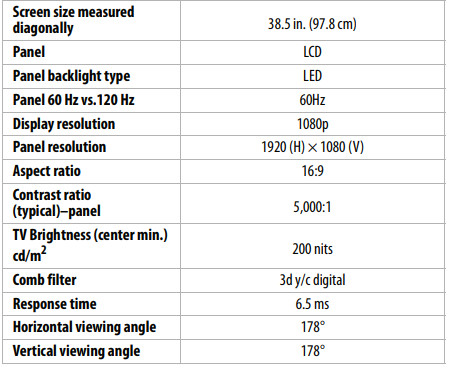
Display resolutions

Tuner

Inputs
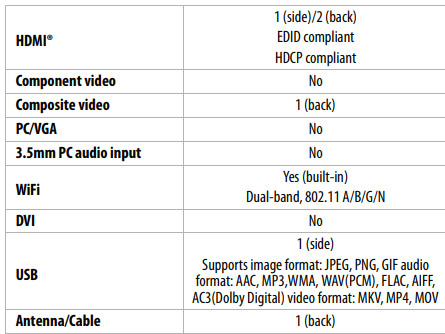
Outputs

Audio

Power

Miscellaneous
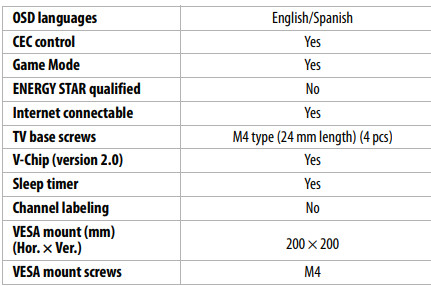
Note The length of the wall-mount screws vary depending on the wall-mount bracket you purchased. See the instructions that came with the wall-mount bracket for screw lengths.
See other models: NS-PC6SS7 NS-WHP314 NS-IC87BK6 NS-32E320A13 NS-DWR2WH8
